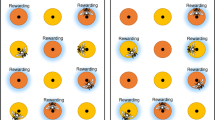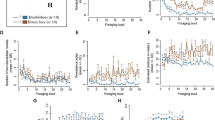Abstract
While there has been considerable research on the behavioral processes that underlie animals’ ability respond to shifting rewards, it remains unclear how animals coordinate multiple processes over time. To investigate this, we compared the behavior of honeybees (Apis mellifera) and bumblebees (Bombus impatiens), in an open-ended search task. Bees were given brief access to a high-quality food source, which then became non-rewarding. Then, over an extended period, we examined (1) bees’ tendency to persist at the depleted site, (2) their tendency to return to a different low-quality food source where they had been foraging previously, (3) their tendency to return to the hive, and (4) how previous reward history influenced their tendency to shift among these options. Compared to bumblebees, honeybees were much slower to abandon the depleted site and were much more likely to make trips to the hive while bumblebees were much more likely to return to the familiar low-quality site. These observed species differences are interpreted in terms of evolved individual and social differences between these species. We show evidence of well-studied behavioral processes such as extinction, negative contrast effects, and reliance on a social group, and provide, for the first time, a picture of how these processes interact with one another as part of a common sequential decision-making process.








Similar content being viewed by others
References
Adams-Hunt MM, Jacobs LF (2007) Cognition in foraging. In: Stephens DW, Brown JS, Ydenberg RC (eds) Foraging: behavior and ecology. University of Chicago Press, Chicago, pp 105–138
Baude M, Danchin E, Mugabo M, Dajoz I (2011) Conspecifics as informers and competitors: an experimental study in foraging bumble-bees. P Roy Soc B-Biol Sci 278:2806–2813
Bitterman ME (1976) Incentive contrast in honey bees. Science 192:380–382
Bitterman ME (1996) Comparative analysis of learning in honeybees. Anim Learn Behav 24:123–141
Blumstein DT, Daniel JC (2007) Quantifying behavior the JWatcher way. Sinauer, Sunderland, MA
Bouton ME (1993) Context, time, and memory retrieval in the interference paradigms of Pavlovian learning. Psychol Bull 114:80–99
Bouton ME (1994) Context, ambiguity, and classical-conditioning. Curr Dir Psychol Sci 3:49–53
Bouton ME (2002) Context, ambiguity, and unlearning: Sources of relapse after behavioral extinction. In. Elsevier, pp 976–986
Bouton ME (2004) Context and behavioral processes in extinction. Learn Memory 11:485–494
Bouton ME (2007) Learning and behavior: a contemporary synthesis. Sinauer, Sunderland, MA
Bouton ME, Westbrook RF, Corcoran KA, Maren S (2006) Contextual and temporal modulation of extinction: behavioral and biological mechanisms. 352–360
Chittka L (1998) Sensorimotor learning in bumblebees: long-term retention and reversal training. J Exp Biol 201:515–524
Couvillon PA, Bitterman ME (1980) Some phenomena of associative learning in honeybees. J Comp Physiol Psych 94:878–885
Couvillon PA, Bitterman ME (1984) The over-learning extinction effect and successive negative contrast in honeybees (Apis mellifera). J Comp Psychol 98:100–109
Cresswell JE (1990) How and why do nectar foraging bumblebees initiate movements between inflorescences of wild bergamot Mondarda fistulosa (Lamiacaea)? Oecologia 82:450–460
Dechaume-Moncharmont FX, Dornhaus A, Houston AI, McNamara JM, Collins EJ, Franks NR (2005) The hidden cost of information in collective foraging. P Roy Soc B-Biol Sci 272:1689–1695
Dornhaus A, Chittka L (2001) Food alert in bumblebees (Bombus terrestris): possible mechanisms and evolutionary implications. Behav Ecol Sociobiol 50:570–576
Dornhaus A, Brockman A, Chittka L (2003) Bumble bees alert to food with pheromone from tergal gland. J Comp Physiol Sensory Neural Behav Physiol 189:47–51
Dyer FC (2002) The biology of the dance language. Annu Rev Entomol 47:917–949
Dyer AG, Spaethe J, Prack S (2008) Comparative psychophysics of bumblebee and honeybee colour discrimination and object detection. J Comp Physiol A 194:617–627
Flaherty CF (1996) Incentive relativity. Cambridge University Press, Cambridge; New York
Frisch Kv (1993) The dance language and orientation of bees, 1st Harvard University Press pbk. edn. Harvard University Press, Cambridge, Mass.
Galef BG, Yarkovsky N (2009) Further studies of reliance on socially acquired information when foraging in potentially risky situations. Anim Behav 77:1329–1335
Gibbon J, Fairhurst S, Church RM, Kacelnik A (1988) Scalar expectancy—theory and choice between delayed rewards. Psychol Rev 95:102–114
Giraldeau L-A, Caraco T (2000) Social foraging theory. Princeton University Press, Princeton, N.J
Giurfa M (1996) Movement patterns of honeybee foragers: motivation and decision rules dependent on the rate of reward. Behaviour 133:579–596
Glimcher PW (2002) Decisions, decisions, decisions: choosing a biological science of choice. Neuron 36:323–332
Greggers U, Menzel R (1993) Memory dynamics and foraging strategies of honeybees. Behav Ecol Sociobiol 32:17–29
Heinrich B (1979) Bumblebee economics. Harvard University Press, Cambridge
Judd TM (1995) The waggle dance of the honeybee—which bees following a dancer successfully acquire the information. J Insect Behav 8:343–354
Kacelnik A, Bateson M (1996) Risky theories—the effects of variance on foraging decisions. Am Zool 36:402–434
Keasar T, Shmida A, Motro U (1996) Innate movement rules in foraging bees: flight distances are affected by recent rewards and are correlated with choice of flower type. Behav Ecol Sociobiol 39:381–388
Komischke B, Giurfa M, Lachnit H, Malun D (2002) Successive olfactory reversal learning in honeybees. Learn Memory 9:122–129
Leadbeater E, Chittka L (2005) A new mode of information transfer in foraging bumblebees? Curr Biol 15:R447–R448
Mackintosh NJ (1974) The psychology of animal learning. Academic, London
Mackintosh NJ (1983) Conditioning and associative learning. Oxford University Press, Oxford
Macuda T, Gegear RJ, Laverty TM, Timney B (2001) Behavioural assessment of visual acuity in bumblebees (Bombus impatiens). J Exp Biol 204:559–564
McNamara JM, Webb JN, Collins EJ, Szekely T, Houston AI (1997) A general technique for computing evolutionarily stable strategies based on errors in decision-making. J Theor Biol 189:211–225
Menzel R (1969) On honey bees memory of spectral colours (reversal learning and learning of several colours). Z Vergl Physiol 63:290–309
Menzel R, Greggers U (1992) Temporal dynamics and foraging behaviour in honeybees. In: Billen J (ed) Biology and evolution of social insects. Leuven University Press, Leuven, pp 303–318
Michener CD (2000) The bees of the world. Johns Hopkins University Press, Baltimore, MD
Moore D, Van Nest BN, Seier E (2011) Diminishing returns: the influence of experience and environment on time-memory extinction in honey bee foragers. J Comp Physiol A 197:641–651
Mota T, Giurfa M (2010) Multiple reversal olfactory learning in honeybees. Front Behav Neurosci 4:1–9
Noble J, Todd PM, Tuci E (2001) Explaining social learning of food preferences without aversions: an evolutionary simulation model of Norway rats. P Roy Soc B-Biol Sci 268:141–149
Nunez JA (1970) The relationship between sugar flow and foraging and recruiting behaviour of honey bees (Apis mellifera L.). Anim Behav 18:527–538
Nunez JA (1982) Honeybee foraging strategies at a food source in relation to its distance from the hive and the rate of sugar flow. J Apic Res 21:139–150
Page RE, Fondrk MK (1995) The effects of colony level selection on the social-organization of honey-bee (Apis mellifera L.) colonies—colony level components of pollen hoarding. Behav Ecol Sociobiol 36:135–144
Pavlov IP (1927) Conditioned reflexes. Oxford University Press, Oxford, UK
Pecoraro NC, Timberlake WD, Tinsley M (1999) Incentive downshifts evoke search repertoires in rats. J Exp Psychol Anim B 25:153–167
Pleasants JM, Zimmerman M (1979) Patchiness in the dispersion of nectar resources—evidence for hot and cold spots. Oecologia 41:283–288
Rescorla R (2001) Experimental Extinction. In: Klein SB, Mowrer RR (eds) Contemporary learning theories—Pavlovian conditioning and the status of traditional learning theory. Erlbaum Associates, Hillsdale, N.J., pp 119–154
Scheiner R, Page RE, Erber J (2001) The effects of genotype, foraging role, and sucrose responsiveness on the tactile learning performance of honey bees (Apis mellifera L.). Neurobiol Learn Mem 76:138–150
Scheiner R, Page RE, Erber J (2004) Sucrose responsiveness and behavioral plasticity in honey bees (Apis mellifera). Apidologie 35:133–142
Schmitt U, Bertsch A (1990) Do foraging bumblebees scent-mark food sources and does it matter. Oecologia 82:137–144
Schuck-Paim C, Pompilio L, Kacelnik A (2004) State-dependent decisions cause apparent violations of rationality in animal choice. PLoS Biol 2:2305–2315
Seeley TD (1983) Division of labor between scouts and recruits in honeybee foraging. Behav Ecol Sociobiol 12:253–259
Seeley TD (1985) The information-center strategy of honeybee foraging. Forts Zool 31:75–90
Seeley TD (1995) The wisdom of the hive: the social physiology of honey bee colonies. Harvard University Press, Cambridge, MA
Seeley TD, Towne WF (1992) Tactics of dance choice in honey-bees—do foragers compare dances. Behav Ecol Sociobiol 30:59–69
Stephens DW (2008) Decision ecology: foraging and the ecology of animal decision making. Cogn Affect Behav Ne 8:475–484
Stollhoff N, Eisenhardt D (2009) Consolidation of an extinction memory depends on the unconditioned stimulus magnitude previously experienced during training. J Neurosci 29:9644–9650
Sutherland NS, Mackintosh NJ (1971) Mechanisms of animal discrimination learning. Academic, New York
Towne WF, Gould JL (1988) The spatial precisions of the honey bees' dance communication. J Insect Behav 1:129–155
Townsend-Mehler JM, Dyer FC, Maida K (2011) Deciding when to explore and when to persist: a comparison of honeybees and bumblebees in their response to downshifts in reward. Behav Ecol Sociobiol 65:305–312
Warrant E, Porombka T, Kirchner WH (1996) Neural image enhancement allows honeybees to see at night. P Roy Soc B-Biol Sci 263:1521–1526
Wei CA, Rafalko SL, Dyer FC (2002) Deciding to learn: modulation of learning flights in honeybees, Apis mellifera. J Comp Physiol A 188:725–737
Wiegmann DD, Wiegmann DA, Waldron FA (2003) Effects of a reward downshift on the consummatory behavior and flower choices of bumblebee foragers. Physiol Behav 79:561–566
Worden BD, Papaj DR (2005) Flower choice copying in bumblebees. Biol Lett 1:504–507
Zimmerman M (1981) Patchiness in the dispersion of nectar resources—probable causes. Oecologia 49:154–157
Acknowledgments
We would like to thank our field assistants, Kim Maida, Mara Trudgen, Kourtney Trudgen, Lora Bramlett, Elizabeth Dean, and Jared Ruddick. We would also like to express our gratitude to Randolf Menzel, as well as the two anonymous reviewers, for their comments. Funding was provided by NSF (IGERT DGE 0114378).
Ethical and legal statement
The procedures described above and all care and handing of bees are in full compliance with the institutional guidelines for animal experimentation and with the laws of the United States.
Statement of disclosure
The authors have no financial relationship with the NSF, beyond the funding of the present study. The authors declare no conflict of interest.
Author information
Authors and Affiliations
Corresponding author
Additional information
Communicated by M. Giurfa
Rights and permissions
About this article
Cite this article
Townsend-Mehler, J.M., Dyer, F.C. An integrated look at decision-making in bees as they abandon a depleted food source. Behav Ecol Sociobiol 66, 275–286 (2012). https://doi.org/10.1007/s00265-011-1275-2
Received:
Revised:
Accepted:
Published:
Issue Date:
DOI: https://doi.org/10.1007/s00265-011-1275-2




